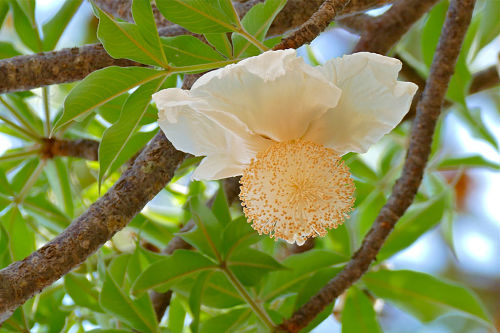
Baobab products
The baobab produces a tangy, highly nutritious fruit! It can be turned into jam, nectar, or powder for use in baking, among other things. Thanks to its exceptional content of vitamin C, potassium, and fiber, the baobab fruit is widely used in nutrition and cosmetics.
Although Madagascar, the country richest in baobab trees, has yet to fully capitalize on this resource, the superfruit is gaining global fame—even reaching Hollywood! The seeds, from which oil is extracted, as well as the leaves, flowers, and bark, also have various uses.
Do you know the baobab?
The baobab is a tree belonging to the Adansonia genus, consisting of eight species. One species is found across Africa, another is endemic to northwestern Australia, and the remaining six are unique to Madagascar. Locally, this majestic tree is called reniala, meaning "mother of the forest."
L’allée des baobab
The baobab is one of Madagascar’s iconic plants, primarily found in the western part of the island. Whether inland, by the sea, or along rivers, baobab trees create stunning landscapes. The most famous is the Avenue of the Baobabs, a cluster of a dozen trees about 30 meters tall, located 19 km from Morondava.
Baobabs along the rivers
The best way to admire the baobabs in Madagascar is by taking a river trek on the Mangoky or Tsiribihina Rivers. Along the way, you'll encounter ridges, canyons, and dry forests. The experience is simply magical !
What is the Baobab used for?
The baobab has always fascinated the Malagasy people, who consider it a unique tree turned upside down by God, with its roots in the air! In some regions, such as the village of Andombiry in southwestern Madagascar (Morombe region), the reniala is an object of veneration. Beyond its cultural significance, the baobab serves many practical purposes.
Water reservoir
In the southern region, on the Mahafaly Plateau, villagers in Ampotaka use baobab trunks as water reservoirs to survive the dry season.

Materials and Medicines
It’s only logical that baobab wood is also put to use—for building walls, tiles, and more. Additionally, the bark, leaves, roots, seeds, and flowers are used in traditional medicine. However, the fruit is the most valuable part.
Is the Baobab edible?
The pulp of the baobab fruit is a superfood! It contains six times more vitamin C than an orange, six times more potassium than a banana, three times more vitamin C than a kiwi, and ten times more antioxidants than goji berries! Every 100 g of baobab fruit powder contains 162 kcal, 1 g of fat, 44 g of fiber, and 42 g of carbohydrates.
The fruit in all its forms
The natural fruit has a tangy and slightly sweet flavor and can be enjoyed as is, by sucking on it. Children are especially fond of it! The pulp can be used to make baobab nectar, baobab jam (similar in taste to coconut milk), concentrated baobab pulp, and more. When processed into powder, it can be used to prepare baobab juice or smoothies.
Baobab Oil
The seeds are also edible and very rich in oil, something you’ll notice when biting into them raw. They can be used to produce baobab oil, known for its nourishing, regenerating, softening, and soothing properties. The oil is yellow, with a fluid and silky texture, and its scent and taste resemble those of nuts. It is also hypoallergenic and anti-inflammatory.

Baobab Honey
When bees extract nectar from baobab flowers (from a variety of small baobab trees), the resulting honey is rare and highly fragrant! This medium-strong, refined honey has a dark color reminiscent of chestnut honey or maple syrup.
